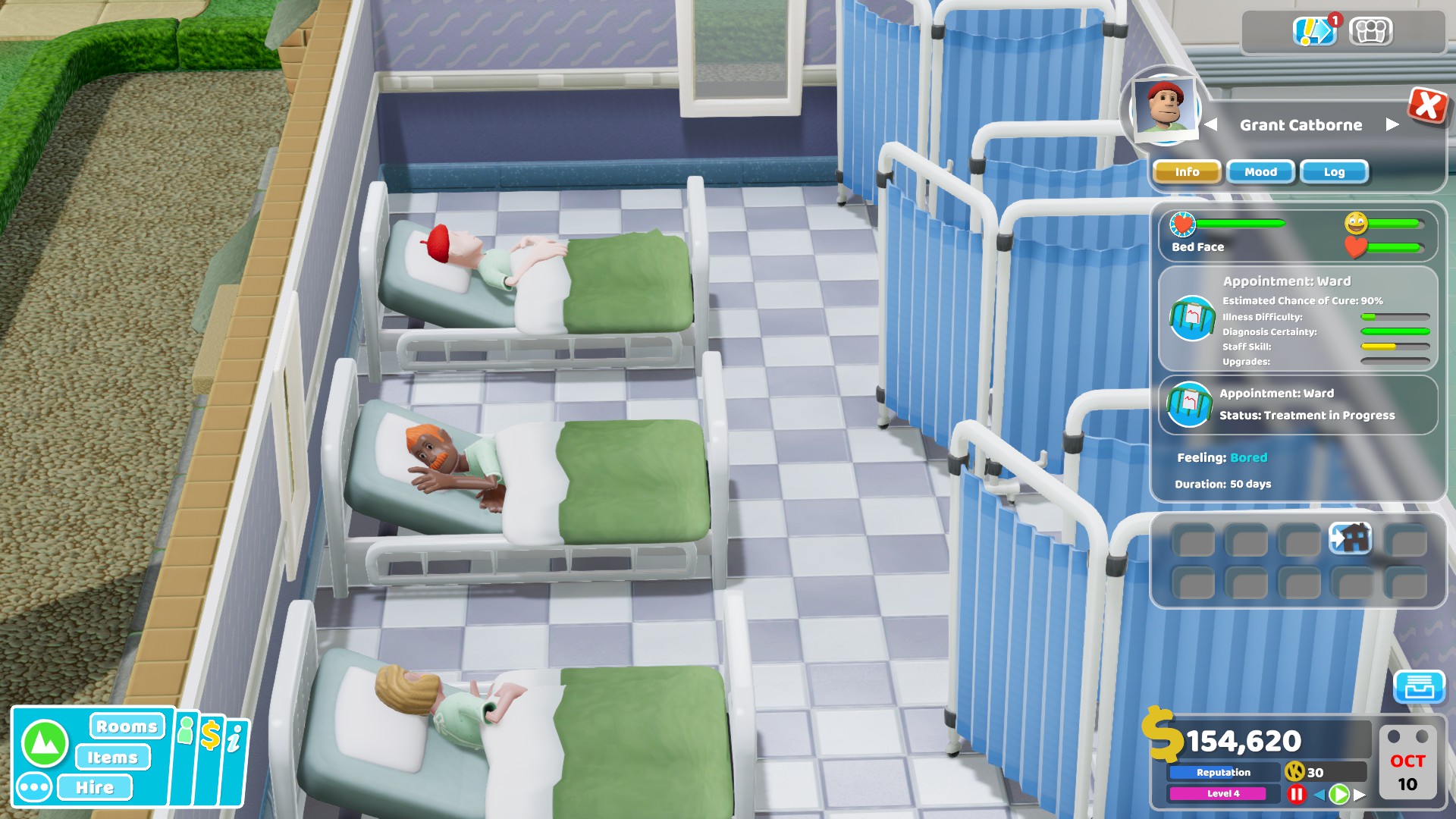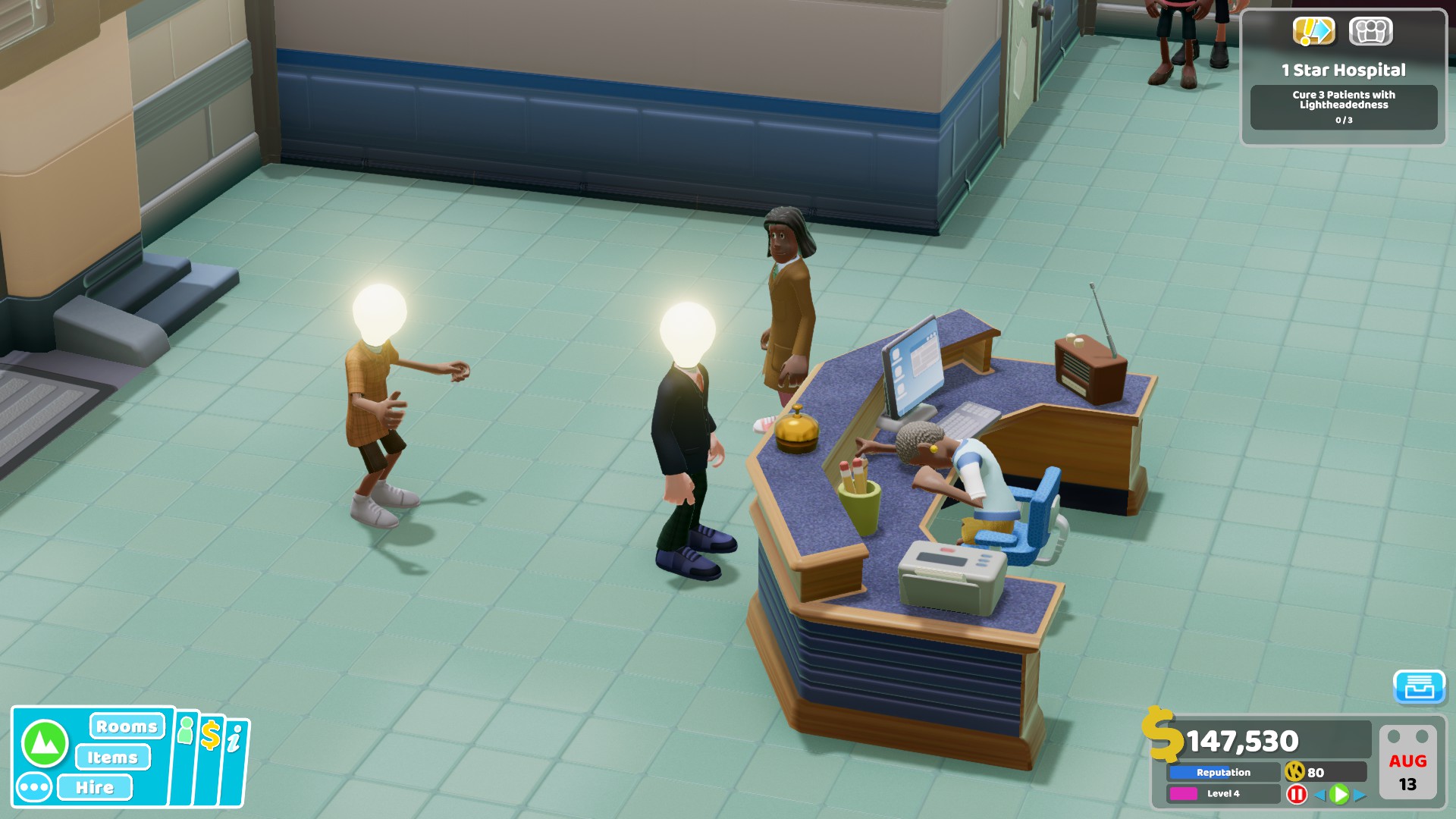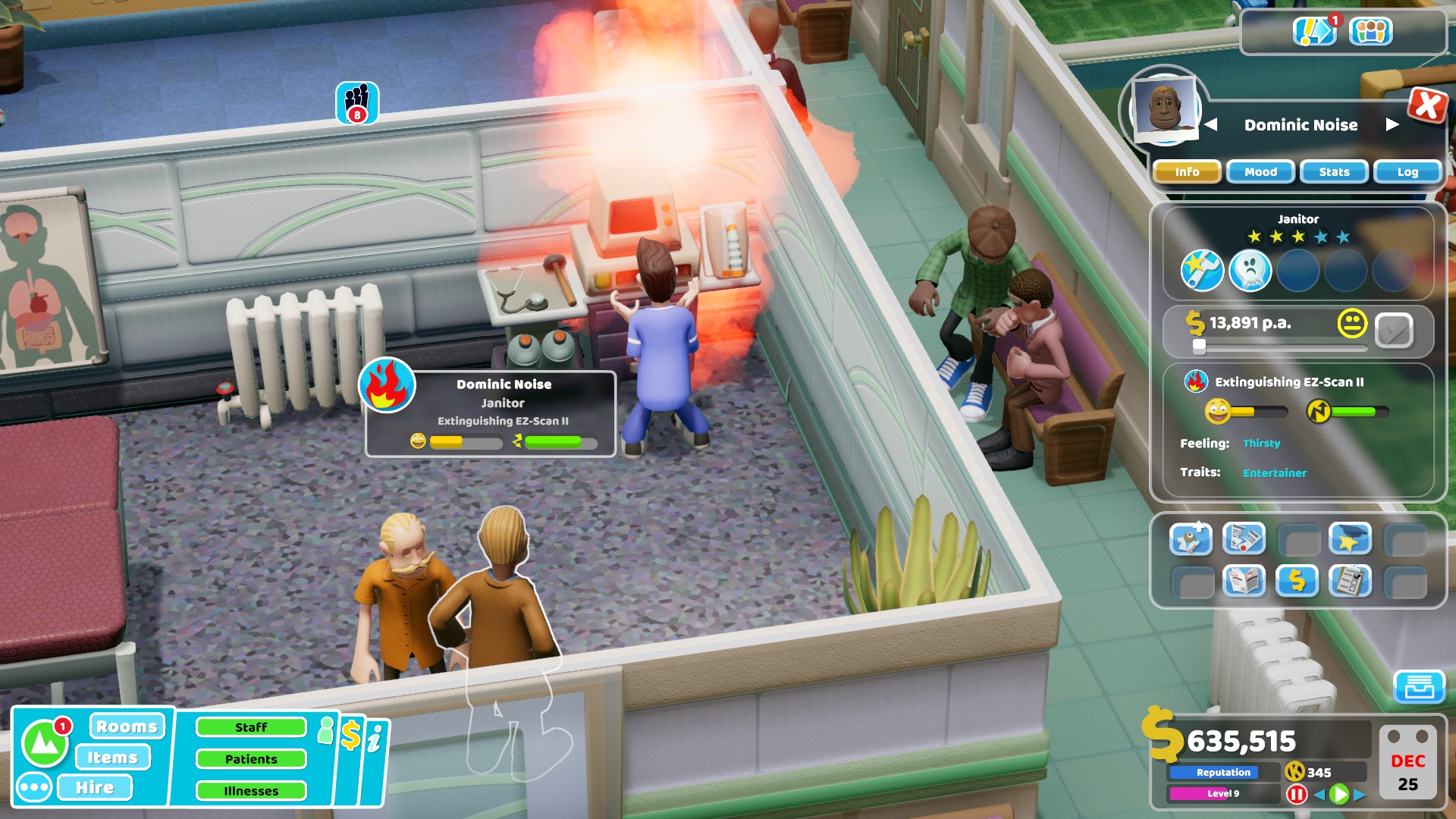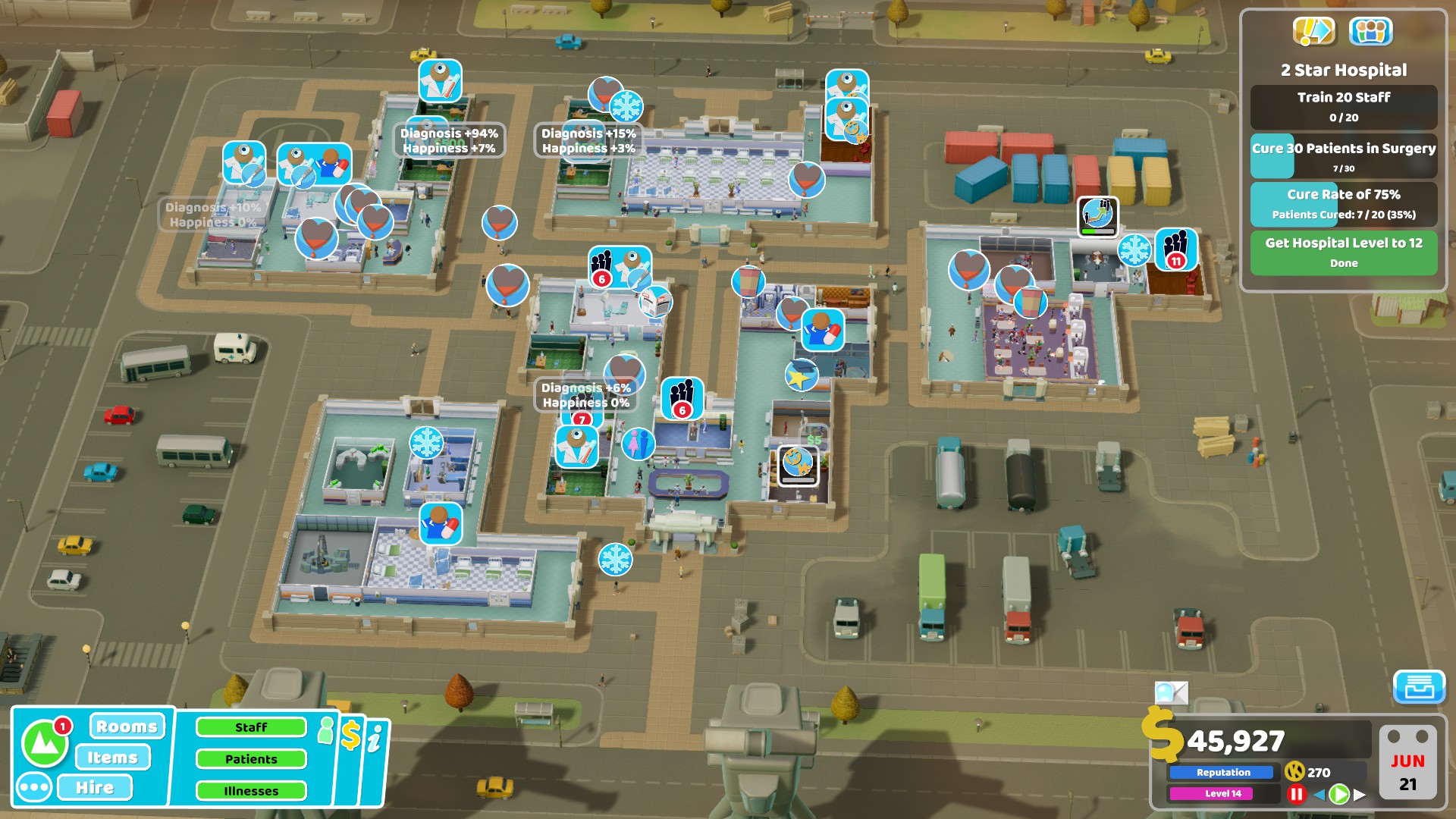Our Verdict
Two Point Hospital is a brilliant management game, regardless of nostalgia.
PC Gamer's got your back
What is it? A hospital building and management sim, and spiritual successor to Theme Hospital.
Expect to pay: $35 / £25
Developer: Two Point Studios
Publisher: Sega
Reviewed on: Intel i5-3570K @3.40 GHz, 16 GB of RAM, GeForce GTX 970, Windows 10
Multiplayer? None
Link: Official site
Freddie Mercury impersonators have completely taken over the hospital waiting area, the clown clinic has caught fire and all of my janitors are busy vacuuming up the angry ghosts of deceased patients. And of course all of this chaos kicks off right when the mayor decides to visit. It’s a pretty normal day in Two Point Hospital, where ridiculous disasters are constantly bubbling beneath the surface, but more often exploding all at once.
Running a hospital is a messy business. Managing the moods of petulant doctors, curing a bizarre list of fictitious illnesses, cleaning up poo and putting out actual fires—there’s little time to sit back and listen to the various radio DJs driving patients mad over the hospital PA system. The upbeat music, silly diseases and constant puns create a false sense of security, but like the Bullfrog and Lionhead romps that preceded it, underneath its tongue-in-cheek exterior is a dense, tricky management game.
Healing hands
Amid the barrage of catastrophes there’s one golden rule: cure as many people as you can. To get the star ratings that will let you move onto the next mission, you’ll need to complete objectives ranging from making the hospital look fetching to finding a cure for being a mime, but you won’t be able to do that if you don’t focus on trying to keep everyone alive. Fail too many of the people relying on you and your reputation will suffer, stopping you from getting quality hospital staff and patients with fat bank accounts.
Initially, the juggling of tasks is kept to a minimum because there are only a few ailments that need your attention. This is in comparison to the later missions where you’ll have massive hospitals, epidemics and more bad jokes (you’ll laugh, but you’ll feel guilty about it) masquerading as diseases than you’ll be able to handle without running out expletives. Even when you can focus on just a few problems, things still have a tendency to spiral.
Even after around 15 missions, I’ve yet to experience a noticeable lull in the hospital drama.
Consider the effort that goes into helping one patient. When they arrive they need to know where to go, necessitating a reception and an assistant to work there. At this point, nobody knows what’s wrong with them, so off they go to get diagnosed. A doctor might be able to help with that, though it usually requires more than one diagnosis, so you’ll be wanting a general diagnosis room, a cardio room and maybe even a ward, all of which have a chance to reveal the mystery sickness. That’s around five members of staff and accompanying rooms, and that’s potentially before treatment has even started. You really have to work for the cure, but it’s all worth it when a big heart appears above their head and they part with their cash.
While patients are shuffling around the halls, they’ll also get thirsty, hungry, bored and maybe even catch another illness if the hospital’s hygiene levels aren’t up to snuff. That means vending machines and eventually a cafe will need to be provided, along with toilets and entertainment, and more staff to maintain them all. Your staff have similar needs, on top of their desire for financial reimbursement, and will eventually start demanding a staff room. Before you know it, you’ve got a hospital.
Even with the foundations built, there’s no time to rest. Impressively, even after around 15 missions, I’ve yet to experience a noticeable lull in the hospital drama. I’ve never found myself twiddling my thumbs, waiting for my researchers to discover new treatments or for a new wing to be finished, because there’s always a medical or administrative conundrum ready to smack me in the face. Greatest among them, my nemesis you might say, is the dreaded queue.
Keep up to date with the most important stories and the best deals, as picked by the PC Gamer team.
The war on queues
As a hospital’s reputation increases, whether that’s because of a good treatment record, a celebrity visit or an aggressive marketing campaign, more patients will start to appear, along with a whole host of weird and wonderful issues. While each treatment has a specific room and device associated with it, every patient still needs to go through the diagnosis process, potentially creating a bottleneck. I can’t count the times I’ve had a perfectly good de-lux clinic (where people unfortunate enough to have light bulbs for heads can be unscrewed, curing them) waiting to be used, but all the patients are stuck outside the general practitioner’s office. Identifying these problem areas and then trying to fix them makes up the bulk of the game, but thankfully it’s a lot less painful than some of the treatments you’ll be offering.
A cacophony of sneezes engulfed my waiting area. I had clowns, disco dancers and pixelated people all getting their snotty hands everywhere. Obviously they all had colds. If I hadn’t noticed that, I might have instead noticed the occasional icicle icon appearing above their heads. Just to be on the safe side, I clicked on a few, bringing up a chart with all their details. These patient charts show everything from who they have an appointment with to their thoughts and mood, making sense out of the chaos. It’s an indispensable tool, and typical of Two Points’ largely excellent UI. It confirmed they all had a cold.
Clicking on a single patient can send you down a rabbit hole for the next hour.
The temperature overlay revealed that the waiting area was exceedingly chilly, and plonking down a couple of radiators (not too many, lest everyone get hot and sweaty), brought the temperature back up to cozy levels. This was indicative of a larger issue, however. They all caught colds because they’d been sitting in that freezing area for days, all waiting to see the same GP. The doctor in question had an alert above her head, showing the number of patients waiting to see her, while clicking on her informed me that she was in dire need of a break and was, in fact, not a trained GP at all. She was an underpaid surgeon filling in for someone. Another problem to fix.
Clicking on a single patient can send you down a rabbit hole for the next hour, fine-tuning your hospital with hand sanitisers to keep out the germs and training sessions so your surgeons can also cover GPs. With each little tweak, you can see the hospital reacting and improving, rewarding you for your efforts. It should feel like you’re getting pulled in a million different directions, stretched to breaking point, but instead one thing naturally leads to another. With one problem solved, you’ll just sort of float into the next one, and because of the interconnectedness of the hospital, you might not even perceive them as two separate problems. It’s one giant organism that you have to treat. I expected to be perpetually stressed, and sometimes I got very stressed indeed, but there was always a solution staring me in the face, or some new diversion to help me forget about my problems.
Building an empire
Each hospital is also just one part of a growing portfolio of private clinics, surgeries and teaching hospitals. By fulfilling each mission’s first objective, you’ll be able to move onto the next, but progression isn’t completely linear. The world is split up into regions, each with three hospitals, one of which is locked, while the others can be tackled in either order. At any point, you can bounce out of your hospital and hit up any that you’ve unlocked. It’s nearly a sandbox, almost but not quite making up for the absence of a proper one. There’s room to experiment and chart your own course, but I’d still love to have a plot of land and no limits.
The main reason to return to old haunts is to get a higher star rating by completing the additional objectives. It’s possible to do them all in one go before moving to the next hospital, but in the later regions they start to become extremely demanding. With new rooms and equipment unlocked in other missions, you can smash through old obstacles with ease.
Progression feels brisk and consistent. New toys are always appearing, a brand new hospital is only ever one objective away, and throughout it all you’re getting rewarded with kudosh, a special currency that can be spent on items to spice up your sterile rooms. There are a few ways to get kudosh, including in-game achievements, but the most reliable way is by completing random challenges, like curing seven people with animal magnetism (they’re literally animal magnets). These items let you flood your hospitals with character, but they also serve a practical purpose, increasing the hospital’s prestige and generally putting everyone in a better mood.
Even if a lot of Two Point Hospital’s missions bleed together, there isn’t a single hospital I haven’t enjoyed running (into the ground).
Despite Two Point Hospital’s penchant for madcap antics and all the memorable disasters I’ve had to deal with, I’m struggling to remember many standout missions. Only occasionally do they put a significant twist on the ‘just build a hospital’ formula. Most of the time you’ll have a new illness to deal with and thus a new room to build, but fundamentally most of these rooms do the same thing—curing and diagnosing—with only visual gags and puns to set them apart. They’re brilliant, all, but they rarely present unique challenges.
The constant escalation still means that no two missions feel completely identical, and new spanners are always being thrown into the works, from freezing temperatures to earthquakes, but all of these things are shared across multiple missions. Earthquakes (and lightning strikes, since they’re essentially the same thing) don’t exactly shake things up, either. The janitors have to intermittently work a bit harder, but it’s barely noticeable.
There are some pleasant exceptions: Managing a teaching hospital where you can only hire rookies who then all need to be methodically trained in a classroom, or taking over a public hospital where you can’t charge money for anything. It’s a shame because few other missions got me to dig through Two Point's systems and really perfect my hospital quite as much as they did. Not that I haven’t had my hands full at every juncture. Even if a lot of Two Point Hospital’s missions bleed together, there isn’t a single hospital I haven’t enjoyed running (into the ground).
While Two Point Hospital does cover a lot of familiar territory, it doesn’t feel like it’s been rudely dragged out of the ‘90s. If you’ve been offering up stethoscopes to Hippocrates’ ghost for a new Theme Hospital, you’ll find it here; but if you’re not craving that fix of nostalgia, Two Points Studios’ spiritual successor will still keep you up to your elbows in corpses and icky illnesses until the wee hours of the morning.
Two Point Hospital is a brilliant management game, regardless of nostalgia.

Fraser is the UK online editor and has actually met The Internet in person. With over a decade of experience, he's been around the block a few times, serving as a freelancer, news editor and prolific reviewer. Strategy games have been a 30-year-long obsession, from tiny RTSs to sprawling political sims, and he never turns down the chance to rave about Total War or Crusader Kings. He's also been known to set up shop in the latest MMO and likes to wind down with an endlessly deep, systemic RPG. These days, when he's not editing, he can usually be found writing features that are 1,000 words too long or talking about his dog.







